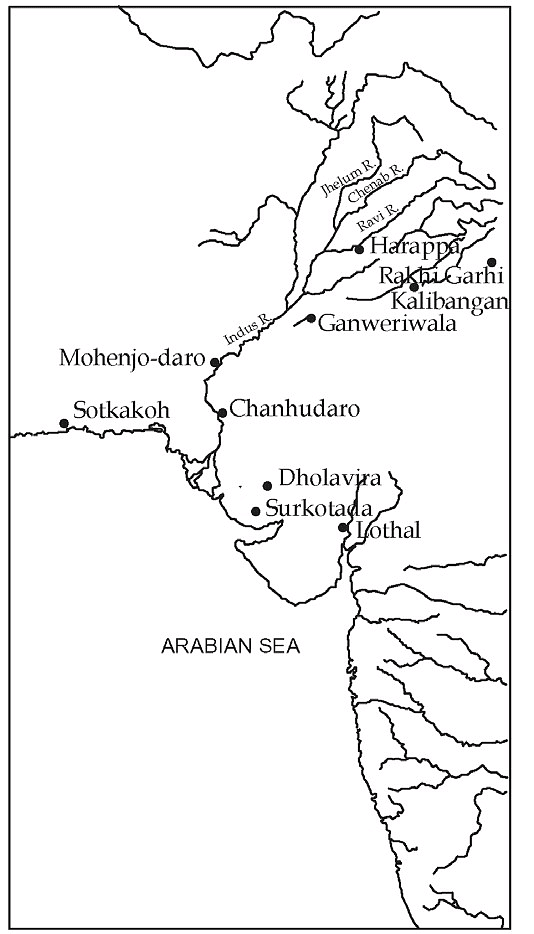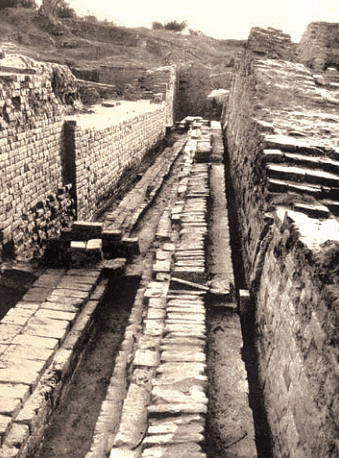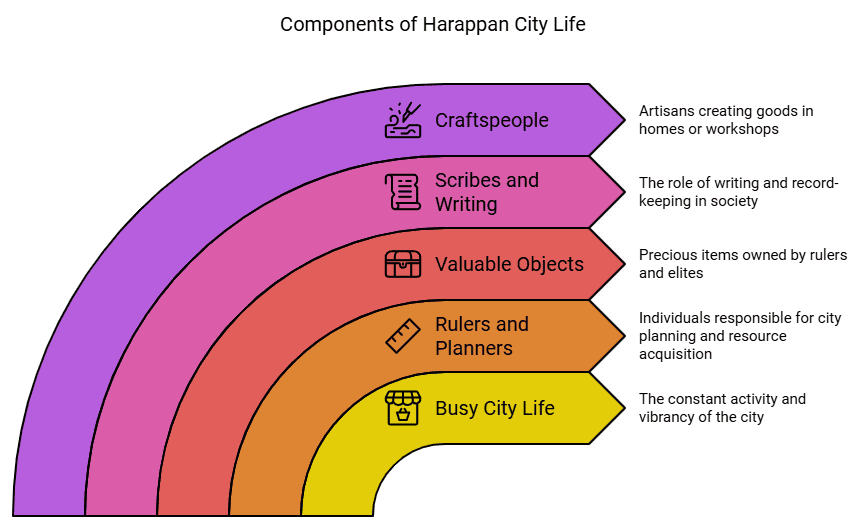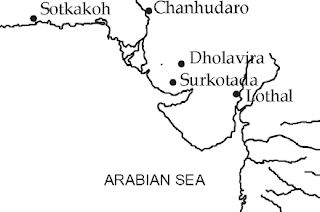Class 6 History Chapter 3 Notes - In The Earliest Cities
Very often, old buildings are pulled down to make way for new construction. In the chapter about 'The First Cities,' you'll read about the Harappa Civilization and its cities. In the end, we will explore the mystery of what happened to the Harappa Civilization.

The Story of Harappa
Around 4700 years ago, the Harappan cities began. Here is a short story about how builders accidentally took apart these sites, and then later, archaeologists found and studied them.
- 150 years ago, while building the first railway lines in Punjab, engineers found Harappa in present-day Pakistan. Engineers thought of the site as a valuable source of bricks, so they took thousands of pre-made, high-quality bricks from the old buildings to build railway lines, destroying many structures of the Harappan site in the process.
- Then, about eighty years ago, archaeologists uncovered the site and recognized it as one of the oldest cities in the subcontinent. Being the initial discovery, all other places with similar buildings and artefacts were labelled as Harappan.
What was special about these Harappan cities?
City Structure: Many ancient cities were divided into two parts: a smaller, higher part called the citadel and a larger, lower part called the lower town.
- Protective Walls: Walls of well-baked bricks were built around each part of the city, creating strong structures that have lasted for thousands of years.
- Where Were They Found: These cities were discovered in places like Punjab and Sind in Pakistan, Gujarat, Rajasthan, Haryana, and Punjab in India.
 Harappan Cities found in Pakistan and India
Harappan Cities found in Pakistan and India - Special Objects: Archaeologists found unique things in these cities: red pottery with black designs, stone weights, seals, special beads, copper tools, and long stone blades.
- Unique Features in Some Cities:
- Mohenjodaro: In Mohenjodaro, a special tank called the Great Bath was built on the citadel. It was lined with bricks, coated with plaster, and made water-tight with natural tar. It had steps leading down to it and rooms on all sides.
 The Great Bath
The Great Bath - Kalibangan and Lothal: Had fire altars where sacrifices might have been made.
- Mohenjodaro, Harappa, and Lothal: Had elaborate storehouses.
These special features help us understand how people in these ancient cities lived and what was important to them.
Houses, Drains and Streets of Harappan Civilization
In these ancient cities, the way people lived was quite fascinating. Let's explore the design of their houses and the clever system of covered drains that made daily life possible.
 How bricks were arranged to build walls in Harappan cities
How bricks were arranged to build walls in Harappan cities
- House Structure: Houses in ancient cities were typically one or two storeys high, with rooms surrounding a courtyard. Most houses had separate bathing areas, and some had wells for water supply.
- Covered Drains: Covered drains were present in many of these cities, carefully laid out in straight lines with a gentle slope for water flow. Inspection holes were provided at intervals to clean the covered drains.
- Connection with Smaller Drains: House drains were connected to street drains, and smaller drains led into larger ones. It is likely that houses, drains, and streets were planned and constructed simultaneously.
 A street in Mohenjodaro with a drain
A street in Mohenjodaro with a drain
Life in the Harappan City
- Busy City Life: A Harappan city was always bustling with activity.
- Rulers and Planners: Some people, probably rulers, planned and built special buildings in the city. Rulers might have sent others to faraway places to bring back metal, precious stones, and other things they wanted.
- Valuable Objects: The rulers likely kept the most precious items, like gold and silver ornaments and beautiful beads, for themselves.

- Scribes and Writing: Scribes who knew how to write played a role in making seals and possibly wrote on materials that didn't survive over time.
- Craftspeople: Men and women, known as craftspeople, made all sorts of things, either in their homes or special workshops.
- Travelling and Stories: People travelled to distant lands, bringing back materials and, perhaps, stories.
- Terracotta Toys: Many clay toys have been found, suggesting that children played with them in these ancient cities.
 Terracotta Toys
Terracotta Toys
New Crafts in the City
- Objects found in Harappan cities are made of stone, shell, and metal.
- Copper and bronze were used to make tools, weapons, ornaments, and vessels.
- Gold and silver were used to make ornaments and vessels.
- Beads, weights, and blades are striking finds.
- Seals made of stone are rectangular and have animal carvings.
 Crafts in Harappan Cities
Crafts in Harappan Cities
- Pots with beautiful black designs were made.
- Cotton was grown at Mehrgarh, and cloth pieces were found in archaeological sites.
- Spindle whorls made of terracotta and faience were used to spin thread.
- Many objects were likely made by specialists.
- Specialists could be either men or women.
In Search of Raw Materials
- Raw materials are substances that are found naturally or produced by farmers or herders.
- Raw materials are processed to produce finished goods.
- Cotton is an example of a raw material that can be processed to make cloth.

- The Harappans used locally available raw materials but also imported items like copper, tin, gold, silver, and precious stones.
- Copper may have been sourced from present-day Rajasthan and Oman.
- Tin may have been brought from present-day Afghanistan and Iran.
- Gold could have come from present-day Karnataka.
- Precious stones may have come from present-day Gujarat, Iran, and Afghanistan.
Food for People in the Cities
- Farmers and herders in the countryside supplied food to craftspersons, scribes, and rulers in the cities.
- The Harappans grew various crops like wheat, barley, pulses, peas, rice, sesame, linseed, and mustard.
- The plough, a new tool, was used for digging the earth and planting seeds.
- Toy models of ploughs have been found, suggesting that real ploughs were probably made of wood.
- Some form of irrigation may have been used due to the region's lack of heavy rainfall.
- The Harappans reared cattle, sheep, goats, and buffalo.

- Water and pastures were available around settlements, but during dry summer months, large herds of animals were likely taken to greater distances in search of grass and water.
- The Harappans also collected fruits, caught fish, and hunted wild animals like the antelope.
A Closer Look- Harappan Towns in Gujarat
- Dholavira was located on Khadir Beyt in the Rann of Kutch.
- It had fresh water and fertile soil- Dholavira was divided into three parts, each surrounded by massive stone walls with gateways.
- There was a large open area for public ceremonies.
- Unique finds include large letters of the Harappan script carved out of white stone.

- Lothal was located beside a tributary of the Sabarmati, close to the Gulf of Khambat.
- It had easy access to raw materials like semi-precious stones.
- Lothal was an important centre for making objects out of stone, shell, and metal.
- It had a storehouse where many seals and sealings were found.
- There was also a workshop for making beads in Lothal, where various bead-making materials and tools were found.
The Mystery of the End
- Around 3900 years ago, there was a major change: people stopped living in cities and stopped using writing, seals, and weights.
- Raw materials brought from long distances became rare.
- In Mohenjodaro, garbage piled up on the streets, the drainage system broke down, and new, less impressive houses were built.
- The reasons for these changes are uncertain, but some suggest that the rivers dried up and there was deforestation.
- Flooding and river drying up would only affect some areas, so it appears that the rulers lost control.
- As a result of these changes, sites in Sind and West Punjab were abandoned, and people moved into newer, smaller settlements to the east and south.
FAQs on Class 6 History Chapter 3 Notes - In The Earliest Cities
| 1. What were the unique features of Harappan cities? |  |
| 2. How did the people of Harappa manage their water supply and drainage? |  |
| 3. What kind of crafts and industries developed in Harappan cities? |  |
| 4. Where did the Harappan people source their raw materials? |  |
| 5. What theories exist regarding the decline of the Harappan civilization? |  |

















